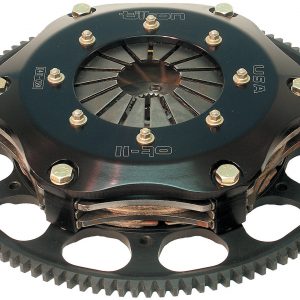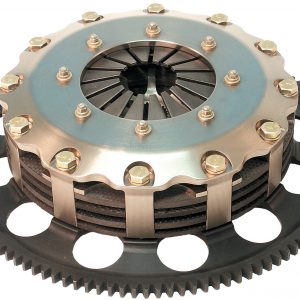Tilton Tackles Honda Clutch Problems
 Changed the clutch in your drag Honda lately? This has to be one of the worst jobs in all of compact car drag racing. Turbocharged, nitrous-fed Honda engines inflict severe damage on clutches after round upon round of heated competition—even some very good “hot rod” clutches.
Changed the clutch in your drag Honda lately? This has to be one of the worst jobs in all of compact car drag racing. Turbocharged, nitrous-fed Honda engines inflict severe damage on clutches after round upon round of heated competition—even some very good “hot rod” clutches.

Tilton does not come to the foray lightly. Just in case you are not that comfortable with the Tilton Engineering name, allow us to set the stage. Tilton clutches and related components have won championships (not just races) in a number of prestigious professional racing series. There is also some drag racing that you import guys might like to know about. Try championships in NHRA Import and NIRA Pro FWD, Pro 4-Cylinder and Power 6. So let’s look at the hardware.
Tilton offers three distinct clutch/flywheel assemblies. We’ll start at the bottom of the food chain, which is an 8.5-inch single Cerametallic disc unit. This is the hot ticket for the street and occasional passes down the strip on weekends. The weight and inertia is engineered to reduce the chance of “bogging,” yet provide faster engine wind-up and smooth, high-rpm shifting. The assembly for a B16/B18 engine is rated at 275 lb-ft torque capacity and the other at 400 lb-ft capacity. Assembly weights are the same at 17.1 pounds. Built-in features are the race-proven, high-strength aluminum clutch cover that is designed to minimize deflection and provide for some slick shifting. A floating steel pressure plate is used for reliability, so there are no straps to break. The components are individually balanced and are completely re-buildable.
Tilton doesn’t half step when it comes to flywheels, either. They are billet steel and light as some aluminum flywheels. Machined from pre-heat-treated 4140 steel, Tilton flywheels are then surface heat-treated for strength and durability. The ring gear is integrally cut into the flywheel for safety. All Tilton clutches come with grade 8 hardware to mount the clutch to the flywheel.
The second Tilton clutch/flywheel assembly for most imports is considerably more robust. This unit features two 7.25-inch Cerametallic discs and offers very high torque capacity and light rotating mass. The unit gets bolted onto turbo/nitrous applications for faster engine acceleration and smooth, high-rpm shifting. All of these dual-disc units are rated at 740 lb-ft torque capacity. The Honda B16A/B18 engines have an assembly weight of 14.6 pounds; the H22 assembly is 15.2 pounds and the Toyota MR2 Turbo is 14 pounds. Again, they are individually balanced and completely re-buildable.

The third and final assembly is of the “serious bar fight” variety. Depending on the application, torque capacity starts at a puny 860 lb-ft and tops out at 1,260 lb-ft for the ’93-’98 Supra MKIV. Weight for this unit is 14 pounds. Make no mistake—this is serious stuff. Clutch material is 100-percent carbon matrix, which is Formula 1 technology, offering high torque capacity, driveability and long life, even for drag racing. The linear engagement characteristics and high heat capacity of the material enable it to be slipped without overheating and damaging the plates. This also reduces stress on other driveline components like transmission internals, half-shafts and related joints.

 By
By 





